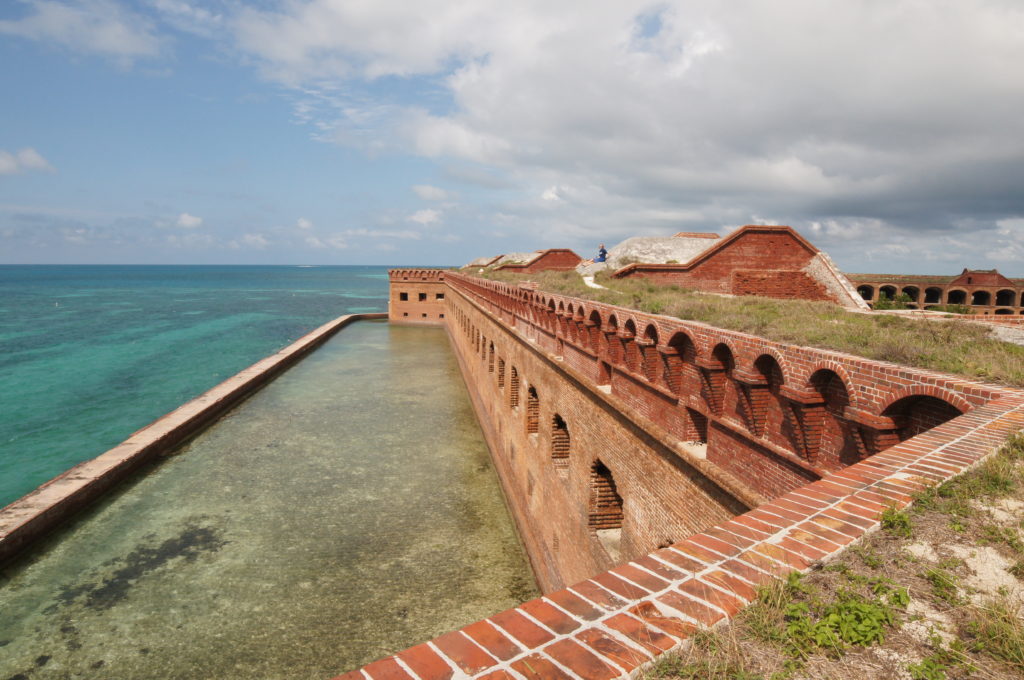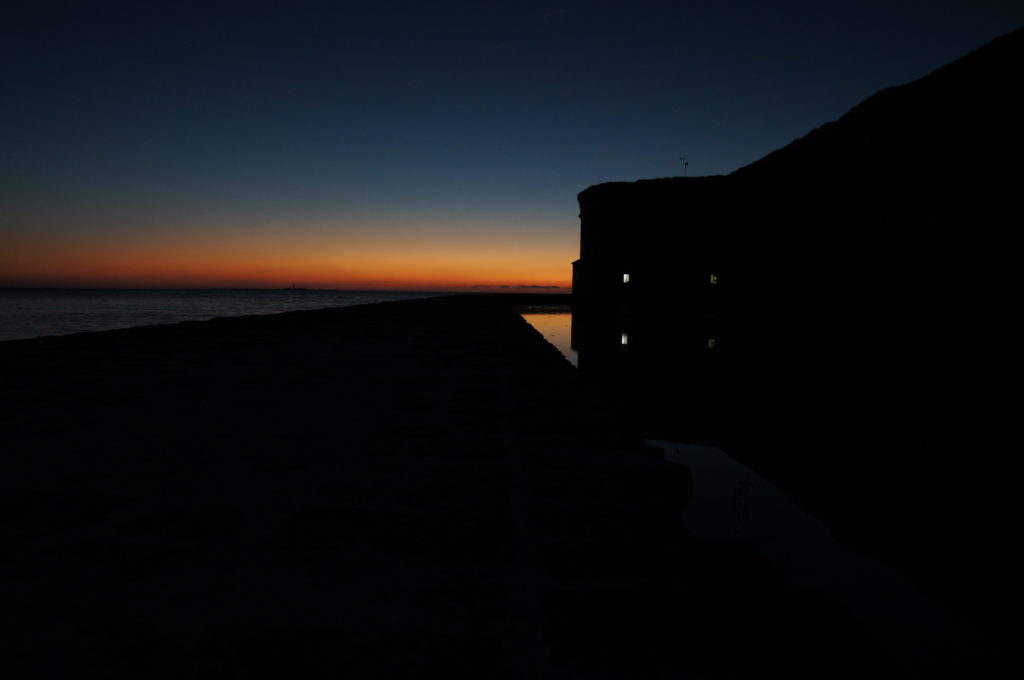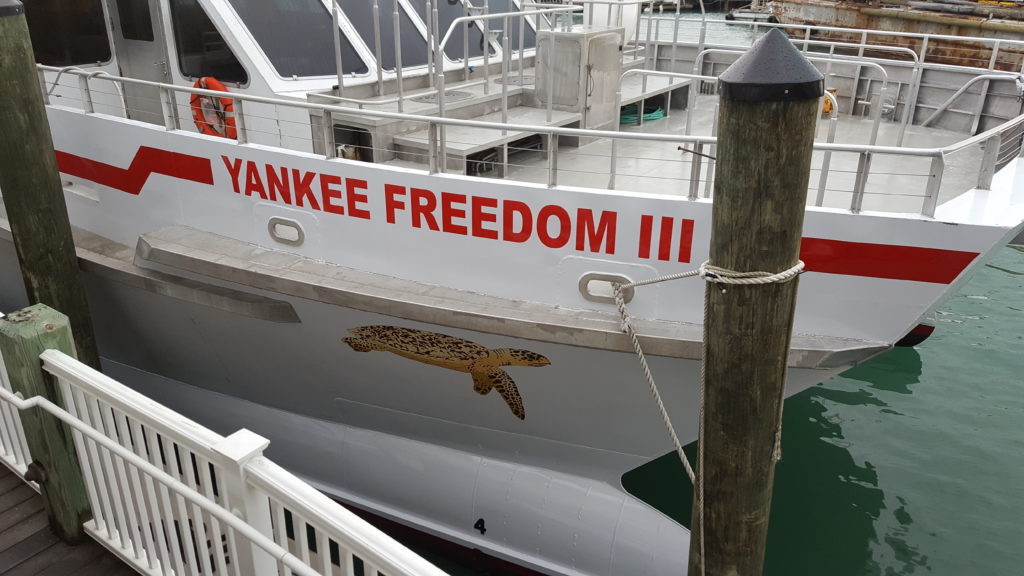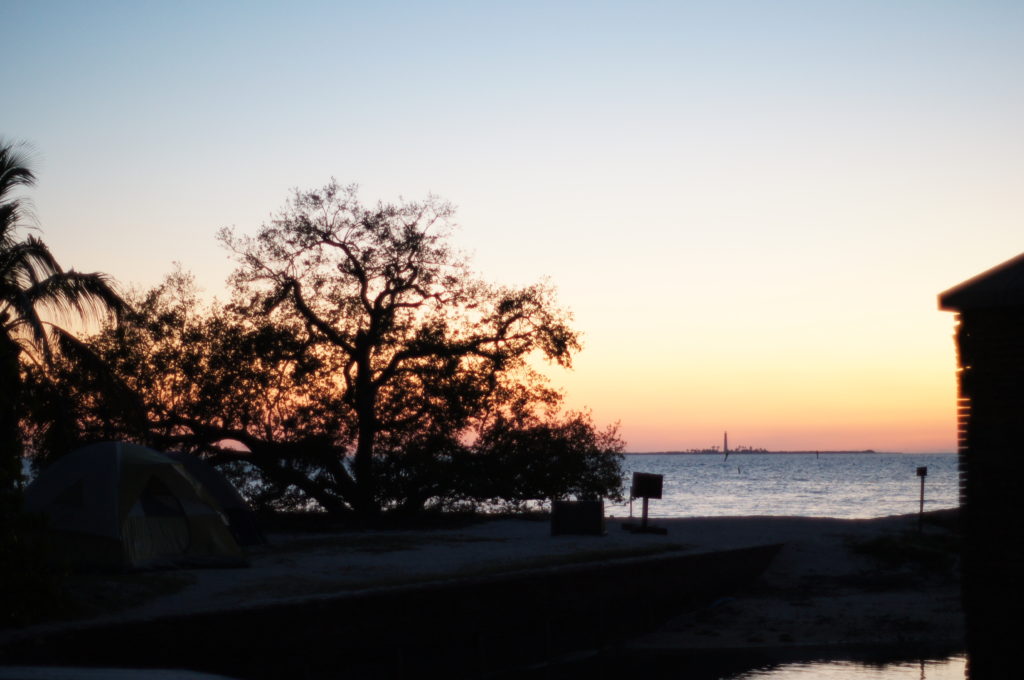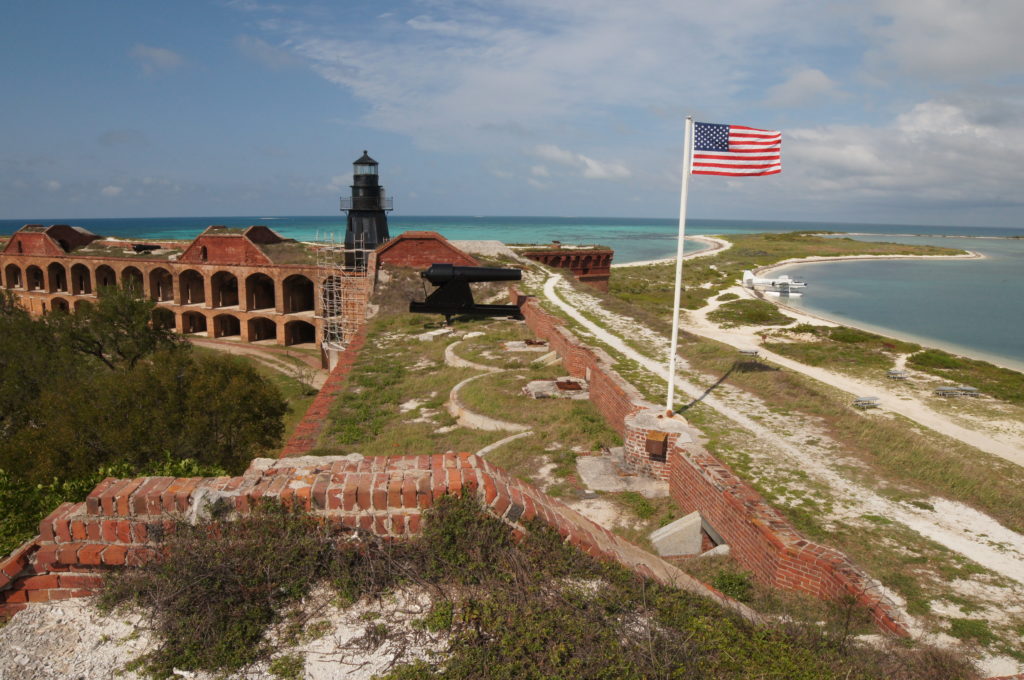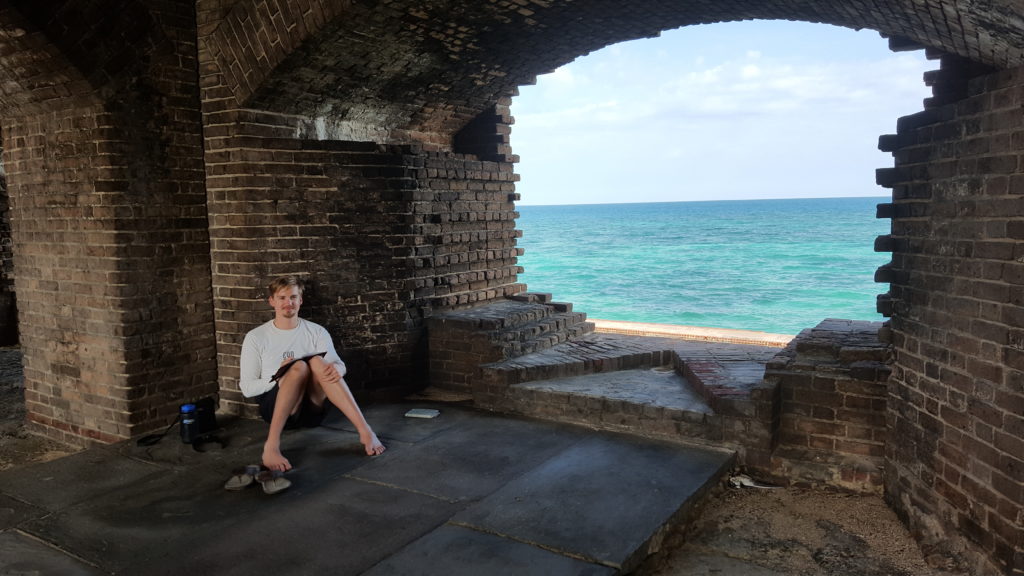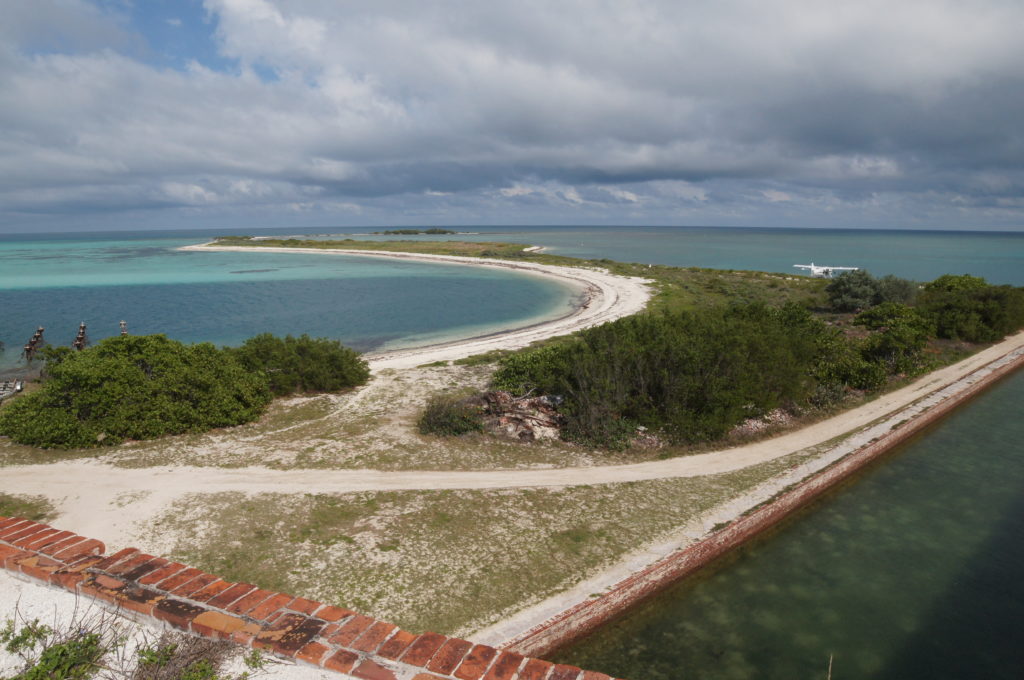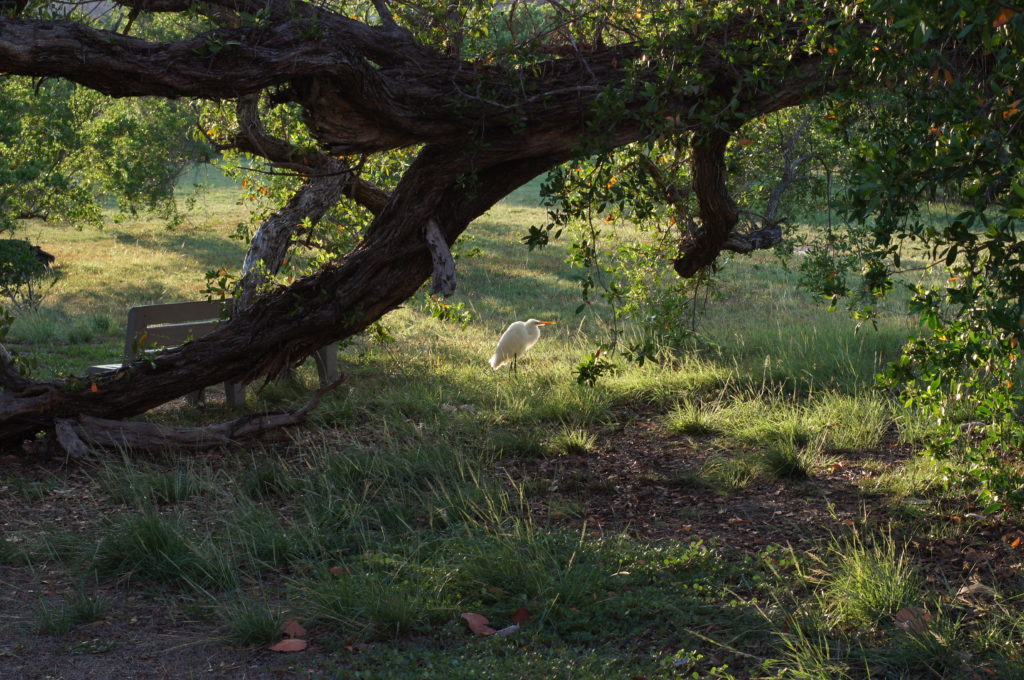From the Battlements of Fort Jefferson in the Dry Tortugas National Park
There are few places where you can truly unplug and escape the frenetic pace of modern life. But camping in Garden Key—a remote island in the Dry Tortugas National Park located approximately 70 miles from Key West and accessible only by boat or seaplane—disconnects you from the rest of the world, both physically and digitally, letting you live in the moment.
Natural beauty and wildlife surround you at the Dry Tortugas National Park. Aquamarine waters stretch as far as the eye can see. Each evening, spectacular sunsets grace the sky—the fiery orb of the sun sinks into the sea, while the sky fills with brilliant pink and golden hues. On a clear night, the stars shine perhaps more brightly than you will have ever seen before, thanks to the lack of light pollution.
Twilight over the Moat Wall at Fort Jefferson in the Dry Tortugas National Park
The Voyage to the Dry Tortugas
The Fort Jefferson Ferry, Yankee Freedom III
Because the Dry Tortugas are so remote, getting there is part of the adventure. The most common way is by the Yankee Freedom ferry—a 110-foot catamaran capable of transporting 250 people. The voyage takes around 2 hours and 15 minutes, and they serve an all-you-can-eat continental breakfast once everyone’s on board. I recommend eating breakfast in the inner cabin and then spending the rest of the trip standing on the prow with the wind blowing through your hair, looking out at the pristine ocean. If you’re lucky, you’ll see flying fish skirt over the water and/or sea turtles swimming beneath the surface. Someone next to us even saw a shark!
Of course, this is dependent on the weather—when the sea is rough, they close the outer deck. This happened on our return journey, when the swells were 5-8 feet. I found this exhilarating (I’m a rollercoaster fiend and enjoy jumping out of planes, so this reaction is not the norm), but a lot of the passengers got seasick, so I recommend checking the conditions the morning of your trip, and if you’re prone to motion sickness or unsure, take Dramamine beforehand. It takes 30 minutes to an hour to kick in, so don’t wait until you feel sick. Please note: I’ve never taken this medicine, but from witnessing many people in discomfort and listening to the crew, I think it’s a good idea if you think there’s a chance you’ll need it.
Camping in the Dry Tortugas
Campground at the Dry Tortugas National Park at Twilight
To camp in the Dry Tortugas National Park and to benefit from the seclusion and remoteness, you must be willing to give up modern-day luxuries. There are no cell towers, no wifi, and no electricity or running water. Some of these can be advantageous depending on your perspective—personally I found it freeing to be disconnected for a few days—while others are simply inconveniences you must endure as a price to access such a wild place.
View of the Dry Tortugas from the Top of Fort Jefferson
The Dry Tortugas is hot, especially in the middle of the day during the summer months. Make sure to bring in plenty of fresh water and sunscreen—all campers who take the ferry are allowed to bring 60 pounds of gear per person, not including water. The general guideline is 1 gallon of water per person per day. During the hottest part of the day, we rested in shady, cool areas of the fort or went snorkeling. We also bought lunch on the ferry (it’s $7 per person for a buffet lunch consisting of cold cuts, cheese, bread, lettuce, chips, fruit, soda, and water) and sat in the air conditioning for a bit to cool off. Lunch is served from 11 AM to 1 PM.
Corey Sitting Inside Fort Jefferson Writing
The ferry departs at 2:15 PM to return to Key West. This is when you really feel the place’s solitude and peace—almost everyone is gone from the island except a handful of campers, and you can walk around without seeing a soul. The only sound is the ubiquitous cry of nesting seabirds and the lapping of waves against the moat wall. It’s a great time to walk around the moat, explore the fort, or swim in the North Shore beach (the beach on the opposite side of the island from the campground).
What to do in the Dry Tortugas
-
Snorkeling in the Dry Tortugas
The diversity of sea creatures is amazing to behold. Rainbow parrotfish—large fish with pink, turquoise, yellow, and green scales and bright blue beaks that give the impression they’re wearing lipstick—swim about happily, using their beaks to scrape algae from rocks and coral. Solitary barracudas lurk on the outskirts of the reef, their shiny silver scales mirroring the water around them and making them practically invisible. We even saw an octopus creeping along the moat wall searching for prey, as well as a sea turtle resting on the seafloor at the bottom of a coral structure.
There are many good snorkeling spots in the Dry Tortugas. Our favorite is where the larger coral heads and reef structures are, but this can be a bit hard to find if you don’t know where to look. Start in the south beach and follow the moat wall straight out, but don’t keep following it when it turns to the right; instead, keep swimming straight out about 100-150 yards, almost to the buoy boundary line. This should take you to the first coral heads, and from there you can turn north (right) to find the others. It’s a bit of a swim to get there, but perfectly safe and totally worth it (the water is never more than 10-15 feet deep). The concentration and diversity of sea life on the reef is spectacular.
If you’re new to snorkeling and/or not comfortable with the swim, I recommend simply following the outside of the moat wall (the inner portion is off limits). Many coral grow along the wall, and fish and invertebrates hide among its crevices. We saw a moray eel near the bottom of the moat wall, hiding halfway underneath a rock, and of course many spiny lobsters.
Another thing camping allows you to do is night snorkeling. (Note that this should only be attempted if you are very comfortable with snorkeling and swimming, if you have waterproof dive lights, and if you take the proper precautions. Remember that you are 70 miles by sea from the nearest hospital, so safety should always come first. Also remember to take currents into account and don’t go far out.) This was my first experience night snorkeling and I was a bit nervous at first. For that reason, we stayed along the moat wall rather than venturing into open waters.
What you see at night is markedly different from the daytime snorkeling experience. For example, the lobsters—normally hidden in caves during the day, with only their antennae poking out—come out in force, skittering around in search of food. We also saw tons of sea cucumbers sliding along coral, which in the daytime you hardly ever see. Perhaps neatest of all, we saw a moray eel swim like a dragon across the sea floor; during the day, they’re oftentimes hiding or stationary.
Snorkeling Tips and Advice
-
-
- Always snorkel with a buddy. You never want to snorkel alone. If an emergency happens, it’s important to have someone by your side that can help or get help for you.
- Bring a swim shirt with SPF. This helps protect you from the sun and reduces the area you will have to apply sunscreen, though make sure to still get the back of your neck and legs as these areas will be most exposed to the sun while snorkeling.
- NEVER touch the coral or wildlife. The reef is like a museum—the organisms are fragile, ancient, and priceless. No matter how pretty or intriguing, resist the urge to touch, and be conscious of where your hands and feet (and fins) are at all times. A simple errant touch can kill a coral that has taken a thousand years to grow. In particular, do not go over coral that’s close to the surface; it might look okay one minute, but when a wave comes it will drop you down onto the reef. Finally, don’t stand up in the water, except in the beach area near the shore.
- Wear Reef-Safe Sunscreen. Coral reefs are already in peril due to global warming, so please don’t make it any worse: wear sunscreen that won’t damage the reefs.
- Don’t shine your flashlight directly at the sea life. Some of this fish are nocturnal and it can hurt their eyes if you shine it directly into them. So be attentive to where you’re shining your light.
-
- Birdwatching in the Dry Tortugas
Bush Key, with Long Key in the Distance
The Dry Tortugas National Park is a great place for birding, especially during nesting season—March through September—when over 100,000 sooty terns roost on Bush Key. Most of Bush Key is closed during this time to protect the terns’ nesting habitat, but you can walk as far as the boundary sign to get a closer look. The best way to get close is to bring a good pair of high-power binoculars, or even better, a spotting scope with a tripod.
You’ll be surprised at the sheer quantity of birds inhabiting this island. Every little space is utilized, with birds nesting in shrubs, cacti, and on the sand dunes, while thousands more circle and swoop in the air. It’s a scene of constant activity and commotion. The raucous birds can be heard day and night, from any point on the island.
In addition to the sooty terns, the magnificent frigatebird—a huge bird with an up to 8-foot wingspan—comes to nest on Long Key, the small island south of Bush Key. Because of their massive wingspan, the frigatebirds are able to ride the thermals rising from the land, rarely having to move their wings. They’re a sight to behold.
Great Egret in Garden Key Bird Watching Area
Another great (and often unused) area for bird watching is inside Fort Jefferson in the grassy parade ground, just left of the entrance. The park maintains a small birdbath with several benches strategically placed in the shade around it. On an island where fresh water is a scarce commodity, a fresh water fountain attracts the attention of Great Egrets, Golden and Hooded Warblers, and other small birds, all wanting a turn. This is an excellent place to rest out of the hot sun and birdwatch.
In fact, there’s more drama than you would expect—each bird species has a distinct behavior. The egrets creep up to the fountain, scaring the little birds away, slowly drinking their fill before slinking away. The warblers tend to be cautious and timid; they frequently glance around their surroundings before taking a quick sip of water and darting away. Other birds play in the water, repeatedly entering it and ruffling their feathers. If you’re into birding, the Dry Tortugas won’t disappoint!
- Exploring Fort Jefferson
 Fort Jefferson Communication Arches
Fort Jefferson Communication Arches
It’s fascinating to walk around Fort Jefferson and envision life there in days past. For modern-day visitors, the seclusion and isolation of the island is a refreshing escape to a beautiful place, but the Fort Jefferson of old was an unrelenting hell for many: despairing prisoners locked away and surrounded by the vast sea; soldiers terrified, suffering, and dying from yellow fever; and people forced to labor in the extreme heat. According to diaries and records from those past residents of the fort, boredom was also a persistent enemy. Luckily, you’ll get to leave at the end of your stay.
Hot Shot Furnace, Officers’ Quarters, and Kitchen Foundations
There is a self-guided tour you can follow that offers insight into the history of the fort, parts of which are in ruins or were never finished. The building with the chimney pictured above (a hot shot furnace) is an interesting tool of war that was used to heat cannon balls until they were red-hot, so that they would ignite target ships. Imagine being one of the soldiers tasked with carrying the red-hot cannonballs using iron tongs—now that would be a scary job!
Fort Jefferson Officers’ Quarters, Kitchen Foundations, and Parade Ground
15-Inch Smoothbore Rodman Cannon (25 Tons)
While most of the military hardware at Fort Jefferson was scrapped some time ago, there are some impressive cannons remaining along the upper battlements. Several Rodman cannons—massive guns that shot 450-pound projectiles and required a feat of engineering to lift into place—are stationed at points around the perimeter. There are also some smaller Parrott rifled cannons, which were more accurate, cutting-edge cannons at the time.
Take caution when walking around the fort, especially on this upper level, as there are no railings or barriers of any kind along the edge, and the paths are uneven. I appreciate this as it preserves the fort’s historic feel, but it means you must be attentive to your surroundings and keep little ones close.
Me in the Lower Level of Fort Jefferson
- Stargazing and Watching the Sunset
Star Trails Captured from the Fort Jefferson Moat Wall
One of the most spectacular things about camping in the Dry Tortugas is the stargazing. With minimal light pollution for many miles, the stars shine in their full brilliance, filling the sky with the twinkling lights that are always there, but rarely seen today. I recommend lying on the moat wall at night to appreciate this ancient splendor.
The Sunset from Fort Jefferson; Loggerhead Key and Lighthouse at Left
The sunsets are equally mesmerizing, and it’s so peaceful to watch them each night. If you want to escape into nature and focus on the simple and beautiful things in life, make a reservation to go camping in the Dry Tortugas. It will give you a chance to unplug and appreciate your surroundings and the people around you.
If you enjoyed reading this post, like my Facebook page and subscribe to my blog to follow my cooking adventures and flavorful journeys!


